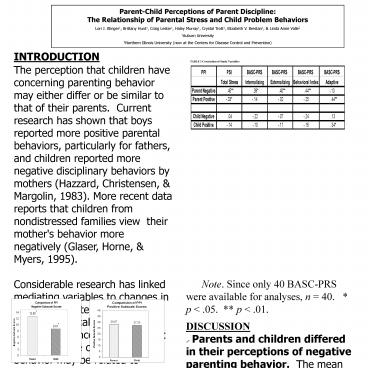ParentChild Perceptions of Parent Discipline: - PowerPoint PPT Presentation
1 / 1
Title:
ParentChild Perceptions of Parent Discipline:
Description:
The Relationship of Parental Stress and Child Problem Behaviors ... All parent and child participants completed an ... The child version has 18 items. ... – PowerPoint PPT presentation
Number of Views:145
Avg rating:3.0/5.0
Title: ParentChild Perceptions of Parent Discipline:
1
Parent-Child Perceptions of Parent
Discipline The Relationship of Parental Stress
and Child Problem Behaviors Lori J. Klinger1,
Brittany Hunt1, Craig Lester1, Haley Murray1,
Crystal Trott1, Elizabeth V. Brestan1, Linda
Anne Valle2 1Auburn University 2Northern Illinois
University (now at the Centers for Disease
Control and Prevention)
INTRODUCTION The perception that children have
concerning parenting behavior may either differ
or be similar to that of their parents. Current
research has shown that boys reported more
positive parental behaviors, particularly for
fathers, and children reported more negative
disciplinary behaviors by mothers (Hazzard,
Christensen, Margolin, 1983). More recent data
reports that children from nondistressed families
view their mother's behavior more negatively
(Glaser, Horne, Myers, 1995).Considerable
research has linked mediating variables to
changes in parent-child interactions (Tein,
2000). Specifically the level of stress
experienced by the parent and the nature of the
child's behavior may be related to parents
disciplinary styles (Dopke, 2000 Maccoby, 2000
Tein, 2000). The primary purpose of this study
is to investigate the correspondence between
parent and child perceptions of discipline as
assessed by the Parenting Perception Inventory.
The secondary purpose of this study is to
investigate the relationship between parent
report of child behavior problems, parenting
stress, and parenting behavior. We hypothesize
that 1. Parents perceptions of parenting
(both positive and negative parenting behavior)
will differ from childrens perceptions of
parenting. 2. Parents and childrens
perceptions of negative parenting will both be
positively correlated with parent stress.
3. Parents and childrens perceptions of
negative parenting will both be positively
correlated with child problem
behavior. 4. Parents and childrens perceptions
of positive parenting will be positively
correlated with child adaptive
behavior. METHOD Participants Fifty-one
parent-child dyads were recruited from the
community using fliers, newspaper ads, and radio
announcements and received 20-25 for their
participation. All parent and child participants
completed an intelligence screener and several
paper-and-pencil questionnaires. The children
ranged in age from 8-12 years old (M 10.26 SD
1.33). There were 20 girls and 31 boys.
Parents consisted of 42 mothers and 9 fathers.
The mean age of the parents was 39.99 (SD
7.50) Measures Parent Perception Inventory
(PPI, Hazzard, Christensen, Margolin, 1983).
The PPI is a measure of perceptions of parental
behavior with two versions, one for the childs
perceptions and the other for the parents
perceptions. The child version has 18 items.
Nine items assess the child's perception of
positive behaviors (e.g., comfort, talk time,
assistance) and comprise the Positive Subscale.
The remaining nine items assess the child's
perception of negative behavior (e.g., criticism,
yelling, ignoring) and are defined as the
Negative Subscale. Scoring for each item ranges
from 0 ("never") to 4 ("a lot"). The parent
version contains 20 items. The first 18 items
assess the same behavior as the child version but
the items are phrased from the perspective of the
parent. The remaining two items of the parent
version were excluded from the analyses. Behavior
al Assessment System for Children-Parent Rating
Scale (BASC-PRS, Reynolds Kamphaus, 1992). The
BASC-PRS is a 138-item, norm-referenced
questionnaire that measures behavioral,
emotional, and adaptive skills in the child. The
four BASC-PRS composite scores (externalizing
problems, internalizing problems, behavioral
symptoms index, and adaptive skills) were used in
this study. RESULTS Two t-tests were conducted
comparing child and parent report on the PPI
Negative Subscale (see Figure 1) and child and
parent report on the PPI Positive Subscale (see
Figure 2). Correlational analyses using the PPI,
the PSI, and the four composite scores of the
BASC-PRS were also conducted (see Table 1).
Correlation analyses between parents and
childrens PPI Positive Subscale scores and
parents and childrens PPI Negative Subscales
were also conducted. The correlation between the
parents and childrens Positive Subscales is r
.33, p lt .05. The correlation between the
parents and childrens Negative Subscales is r
.26., p lt .07. FIGURE 1 FIGURE
2 p lt .05
- TABLE 1 Correlation of Study Variables































